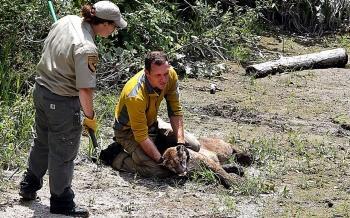In state experiencing extreme dryness, climate is not likely to blame for wildlife entering populated areas
by Haya El Nasser / Al Jazeera

Paul Houghtaling of the UC Santa Cruz Puma Project holds upright the head of a tranquilized young male mountain lion found in an aqueduct near downtown Santa Cruz, California. Photo: Dan Coyro / Santa Cruz Sentinel / AP
LOS ANGELES — A bear wandered into a public park in San Luis Obispo County and sent Little Leaguers scampering for shelter. Who’s to blame? The drought, of course.
Mountain lions are jumping fences in northern California and killing goats. Whose fault? The drought again.
In California, a state suffering its third year of extreme dryness, the crippling drought has become the go-to culprit for situations in which humans are more likely responsible.
For decades, sprawling development into natural habitats has brought wild animals face to face with humans. But several scientists say the drought can’t be blamed — yet — for reducing food and water supplies in the wild.
“A bear coming to a kids’ baseball game is a little unusual, but there are a lot of bears in San Luis Obispo,” said Andrew Hughan, information officer at the California Department of Fish and Wildlife. “Wildlife incidents, especially right now … are perfectly normal spring behavior. Animals come out of their winter down period and are actively looking for food.”
Technology also plays a role. The prevalence of video cameras has resulted in more documented sightings, Hughan added.
Kevin Brennan, a wildlife biologist with the agency in Escondido, said that bears and mountain lions have actually been showing up in urban communities for decades. “It happens when we have fires, and it happens when we don’t have fires,” Brennan said. “The public at large makes a lot of associations that scientists can’t make … The drought has nothing to do with it.”
Wild animals have always ventured into urban territory, where they find a smorgasbord of ready-made food in trash cans and picnic areas.
“In many cases, resources along the edge of the suburbs are far more reliable than resources out in the wild, because every year people are going to irrigate their fruit trees. Every year they’re going to irrigate their lawns,” said Tom Scott, University of California Cooperative Extension specialist. “Animals are quick to use resources that are available.”
So much so that the black phoebe bird, which once inhabited remote areas near streams, is now ubiquitous in suburbs, where it finds plenty of water in swimming pools, Scott said.
The drought has had a real impact on wildlife in other ways. However, the most severe impact is not so apparent to the human eye.
State and federal agencies for fish and wildlife have trucked 26 million Chinook salmon from five Northern California hatcheries to the Sacramento River and San Francisco Bay, Hughan said. Young salmon or “smolts” are poor swimmers, and without rain and snow runoff they may not get flushed down rivers where they spawn.
Another 900,000 smolts hitched a ride out to sea last week. “The only species dramatically affected by drought is salmon,” Hughan said.
The drought may not be forcing wildlife into suburban backyards, but it has taken a toll on their reproduction, Scott said. “This is the third year of drought, and that’s three bad years of reproduction for wildlife species,” he said.
“Wildlife population is starting to decline. It’s attrition rather than a catastrophic drop, but if we went through another drought year, who knows?”

